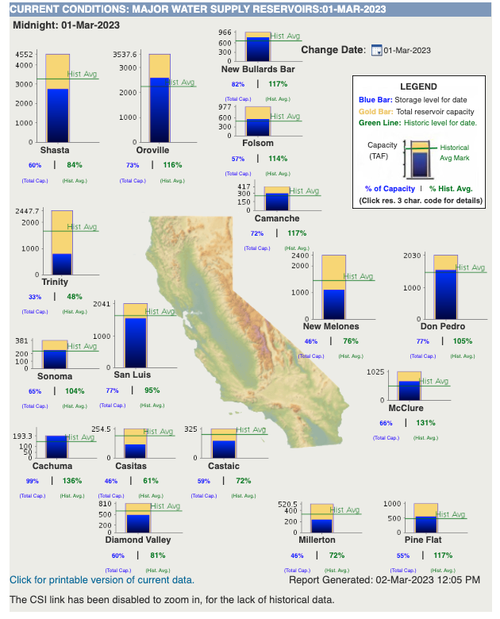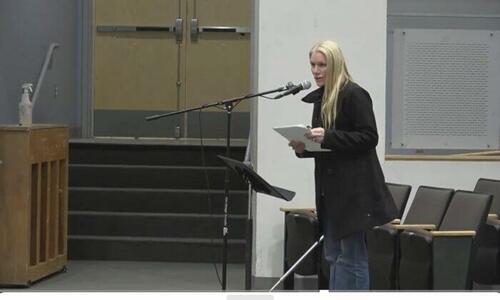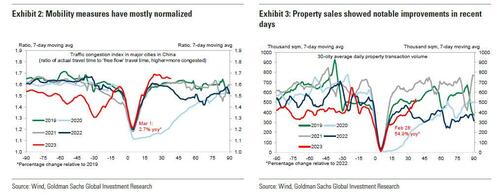Authored by Marie Hawthorne via The Organic Prepper blog,
Preppers get called conspiracy theorists a lot. It’s supposed to be demeaning, but considering how many conspiracy theories have been proven correct lately, I no longer consider it an insult. The more time goes by, the more “conspiracy theorists” just seem ahead of the game.
Quite a few “conspiracy theories” have recently come to light as actual facts in 2023 already. And it’s only the beginning of March.

Let’s look at a recent batch of “conspiracy theories” that aren’t really theories any more.
Gas stoves in peril?
In January, the OP ran a story about the potential ban on gas stoves. Naturally, the mainstream media poo-poohed the idea that the government would do something like that. The New York Times insisted that “No, Biden is Not Trying to Ban Gas Stoves.” CNN likewise claimed Biden didn’t want to ban the stoves NPR dismissed the thought of banning gas stoves as a right-wing, culture war stunt.
Well, maybe they’re not going to outright ban gas stoves. . . but the Department of Energy is proposing new efficiency standards that will make approximately half the gas stoves on the market no longer available. So, technically this isn’t a ban, but regulating gas stoves out of existence has the exact same effect.
This is particularly problematic for anyone with fairly new models. Newer appliances are made to break down within about ten years. Anyone who’s been a homeowner for more than a decade knows this. If appliances are made to only last ten years or so, the government doesn’t need to conduct some dramatic midnight raid to steal your stove. All they have to do is wait. Within ten years, most people will have to replace their stoves anyway, and at that point, very few, if any, gas stoves will still be on the market.
Nope, it’s not just a theory. They really do want to get rid of gas stoves.
Covid origins?
And in other Department of Energy news, the agency recently came to the conclusion that Covid probably did come from a lab. The findings were part of a classified report, which the government agency shared with the Wall Street Journal last weekend.
Back in 2021, the FBI had been the only federal agency to state with “moderate confidence” that Covid came from a lab. At the time, their finding mostly went ignored. However, with another agency admitting it, and WSJ covering the story, it becomes more difficult to brush aside.
And at least we’re allowed to openly discuss the lab leak now. Two years ago, we weren’t. In February 2021, Facebook banned any discussion of the possible laboratory origins of Covid. The lab leak theory was just too crazy to even consider. Zero Hedge was banished from Twitter for daring to suggest the makeup of the virus was peculiar in 2020. The Organic Prepper was called a disinformation site and defunded due, in part, to our coverage of the virus.
But now, House Republicans are launching an investigation into the origins of Covid. And once the Wall Street Journal publishes something, even the stodgiest Boomers can’t ignore it.
The Covid lab leak theory is slowly but surely looking less like a theory, and more like an established fact.
The Covid vaccine?
This is hardly the only situation in which Covid dissidents have been proven correct. There has been a small contingent of people from the beginning who were reluctant to participate in the trial of a novel medical product. Considering the many criminal payouts Big Pharma has had to make over the years, wanting long-term studies before trying a novel pharmaceutical product shouldn’t be controversial.
The cost (injecting a poorly-tested novel substance) did not match up with the benefit (avoiding a not-particularly dangerous disease that many of us had a natural immunity to anyway). Plenty of well-informed people had perfectly rational reasons for vaccine hesitancy.
Were our concerns taken seriously? No. The Othering was vicious and relentless. Daisy wrote an article about it here. Family relationships were stressed and sometimes broken. Careers were ended. Opportunities were denied. Reputations were ruined.
And meanwhile, the “safe and effective” drumbeat resounded. Anyone who wanted real answers about what was happening, who wanted to wait for long-term studies, was dismissed as a conspiracy theorist.
So, who was right? Were the shots safe and effective? Or were the conspiracy theorists the reasonable ones?
I’m not a doctor or statistician. All I can do is point at actual numbers. And even the most pro-vax publications cannot hide the non-Covid excess mortality of the past two years. Young, formerly healthy people have been dying at far higher rates than they used to, and it’s not from Covid. As of right now, no one can prove that jabs are responsible, because no one wants to look that closely. But we can’t prove they’re not responsible, either. Safe? I’m not convinced, and neither are a lot of vastly more qualified people. Just look at Ed Dowd’s meticulously researched book, Cause Uknown.
And even Tony “The Science” Fauci recently admitted that the shots don’t really work at preventing transmission or infection. So, nope, these jabs aren’t effective either.
Meanwhile, Congress is finally launching an investigation into the safety of the forced vaccine.
Were the conspiracy theorists right to be cautious about the new shots? Yeah, I think so.
Mandatory masking?
And what about the masks? We got mixed signals about masks from the beginning. In March 2020, Dr. Fauci said they didn’t work, then he later changed his tune. Many people around the country had to deal with mask mandates for over a year.
Well, the experts at the Cochrane Library recently published a huge meta-analysis of the effectiveness of physical barriers (like masks) at preventing respiratory viruses (like Covid). They can’t find any strong links between masking and disease prevention. Cochrane studies are the gold standard. They’re very conservative, they rarely make hard and fast statements, but once they do, people typically stop arguing.
The mask debate is one that really smacks us at the OP because, back in 2021, NewsGuard cited our questioning of the mask narrative as a reason to downgrade us, which really hurt our income stream. Daisy goes into the whole story here. She cited studies with a variety of outcomes regarding masks, and NewsGuard saw the variety of viewpoints as reason enough to downgrade us.
The journalism majors working at NewsGuard don’t seem to understand that letting multiple educated people argue is more true to the scientific ideal than top-down authoritarian mandates.
I’m not the only person saying this. Dr. Jay Bhattacharya, a Stanford professor and MD, said as much in a recent interview with Jordan Peterson. At 5:26, he talks about public perception during the pandemic:
There was this sort of uni-vocal conclusion that you had to do lockdowns, you had to wear masks, you had to socially distance, you had to put plastic barriers up, you had to close schools, you had to do all of these things; that the vaccines would stop transmission of the disease, that therefore it was warranted that people would lose their jobs over them. All of these ideas were sold as if there was a scientific consensus in favor of them. That was a lie. There was never a scientific consensus on almost any of the topics; and as you say on masks, in fact, the preexisting narrative, the preexisting idea of most scientists before the pandemic, was in quite the opposite direction.
Dr. Bhattacharya’s not the only highly qualified doctor speaking out, either. In fact, so many of the various Covid narratives have been proven wrong, that Dr. Marty Makary, chief of Islet Transplant Surgery at Johns Hopkins medical school, recently published an article February 27 titled “10 myths told by covid experts—and now debunked.”
“Masks prevent transmission” is #2 on the list. I guess if NewsGuard still thinks Daisy is a conspiracy theorist over this one, she’s got some pretty kick-ass company.
But in all seriousness, thank God (or whoever you pray to) for doctors like Dr. Bhattacharya and Dr. Makary for not treating the public like we’re mentally impaired rodents. There are still a few true medical experts out there who genuinely want to educate the public, and give us real answers.
The air and water in East Palestine?
In the meantime, I wonder if the EPA will find any real experts. That agency keeps insisting that the air and water in East Palestine are perfectly safe, despite the derailment and subsequent disaster going on a few weeks ago.
The EPA says they’ve been testing for everything and that the numbers indicate everything looks good; professional chemists aren’t so sure. “They should be testing for individual compounds, and if they are testing for total VOCs [volatile organic compounds] as a screen, they need to have very sensitive instruments because some VOCs are much more toxic than others,” says Ted Schettler, MD, and science director at the nonprofit Science and Environmental Health network. The fact that East Palestine residents are still smelling off odors suggests that the EPA is not using sensitive enough equipment.
And the EPA hasn’t started testing for the myriad other substances that formed when the known chemicals in the train were burned. When you mix chemicals together and burn them, new chemicals form, and this hasn’t even been talked about much yet.
It’s probably going to be a long time before we have a good picture of the damage caused by this derailment. But, what do we know?
We know that the people of East Palestine are still suffering from bizarre symptoms. Rashes, shortness of breath, and a burning sensation while breathing are common. Some people have had voice changes, loss of taste and smell, and random infections. Because East Palestine is such a low-income area, doctors can’t do the tests they need to, though they all agree that the citizens are in real pain.
And yet EPA Administrator Michael Regan states, “Nothing is coming back that shows adverse health impacts.”
Government officials are not helping themselves by insisting there’s “nothing to see here!” Distrusting the federal government has traditionally been in the realm of conspiracy theorists, but once again, which group of people seems more reasonable?
The Twitter files?
I’ve spent a lot of time wondering if I’m too cynical, too eager to see ill intent.
Then came the Twitter Files.
We’ve written about them before on this site. When Elon Musk bought Twitter, he handed over internal documents to independent journalists Bari Weiss, Matt Taibbi, Michael Shellenberger, and Lee Feng to peruse.
Many figures in alternative media had suspected they were being shadow-banned, or having a hard time reaching followers. The Twitter Files confirmed everyone’s worst suspicions: the federal government does spend millions of dollars policing online content, and much of it targets law-abiding citizens with inconvenient opinions, rather than real criminals. Many of the people that had their accounts locked or frozen weren’t even big media presences, just people with a few dozen followers with an annoying sense of humor, or who got snarky about the wrong things.
Five years ago, anyone convinced the Feds were watching their every online move would have been labeled a crazy conspiracy theorist.
Well, yet again, the conspiracy theorists have been proven correct.
The gaslighting continues.
If you’ve ever been in an abusive relationship, you probably know what it’s like to have someone trying to convince you you’re crazy. The only way to survive gaslighting like that is to constantly remind yourself of things you know are true. That’s why it’s so important to keep track of whatever narratives we’re supposed to swallow and constantly check them against our preexisting knowledge base. It’s important to hold purveyors of false narratives to account; it’s important to point to tangible facts and to be able to discuss them.
These are only the most recent examples of conspiracy theorists being proven correct. Daisy had an article about “7 Things That Used to Be ‘Crazy Conspiracy Theories’ Until 2020 Happened.” The tin foil hat wearers have been getting vindicated a lot in the past few years.
I think we’re going to keep seeing more of this for a while. Universal Basic Income, digital currencies, AI tech, there are so many new things happening right now.






















